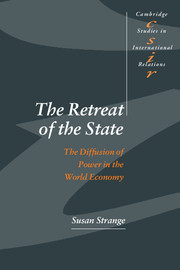Book contents
5 - The state of the state
from Part I - Theoretical foundations
Published online by Cambridge University Press: 07 October 2009
Summary
Scholars in international relations spent a great deal of time in the last thirty years arguing about, comparing and analysing various paradigms, or conceptual perceptions, of the international system. In the 1970s they were also arguing about methodologies – how to study and research international affairs. These debates continue.
But by the closing years of the twentieth century, the major debate in international studies is a new one. It is between those scholars who think that, even after the end of the Cold War, very little has changed, and those who are convinced a great deal has changed (Krasner, RIPE, 1994; Strange, RIPE, 1994). Since the central hypotheses of this book belong in the latter camp, and since the fundamental argument is really about the role of states in the international system, serious consideration has to be given to the views of those who maintain that, in essence, there has been, and still is, continuity in the international system from its inception. Some would go so far as to say it all started with the Sumerian city-state in the 3rd millennium BC and continued right up to the collapse of the Soviet empire nearly 5000 years later (Watson, 1993; Buzan, forthcoming). That longue durée view of human history is perhaps extreme – the historical sociologists emphasise that in ancient Mesopotamia as in ancient central America, state authority owed so much to religious superstition that it has little in common with the modern secular state.
- Type
- Chapter
- Information
- The Retreat of the StateThe Diffusion of Power in the World Economy, pp. 66 - 88Publisher: Cambridge University PressPrint publication year: 1996

